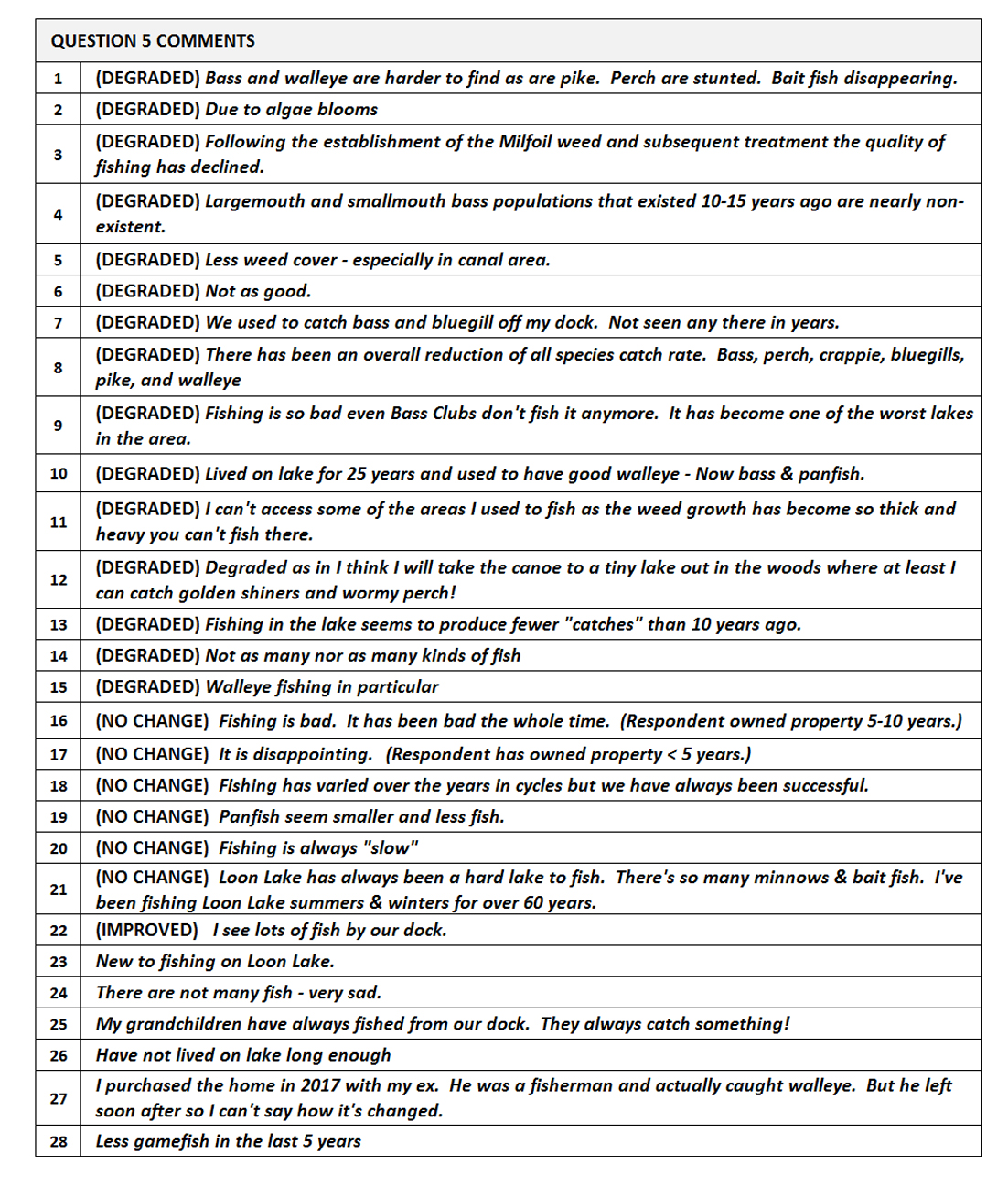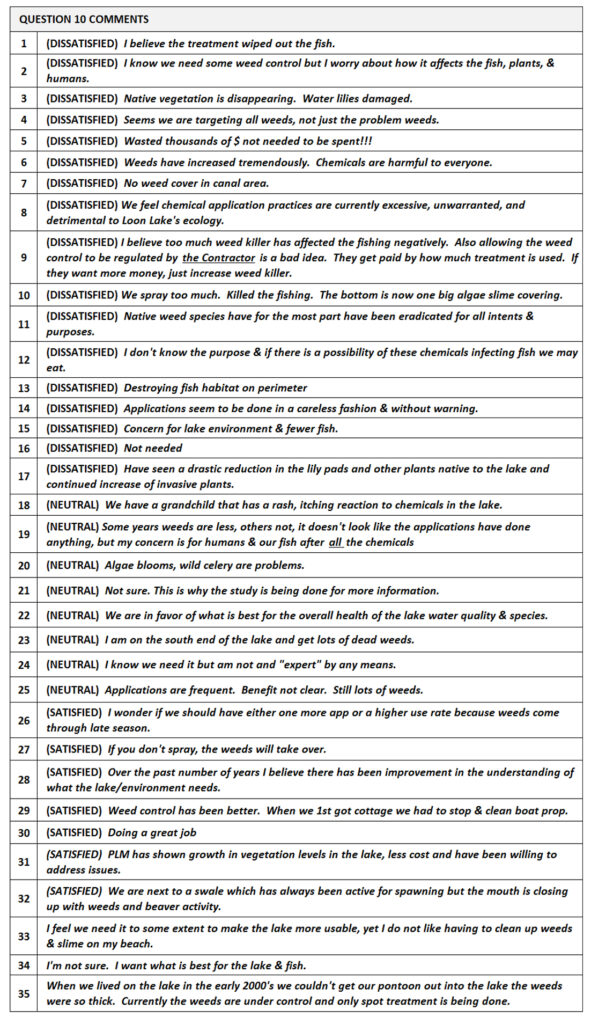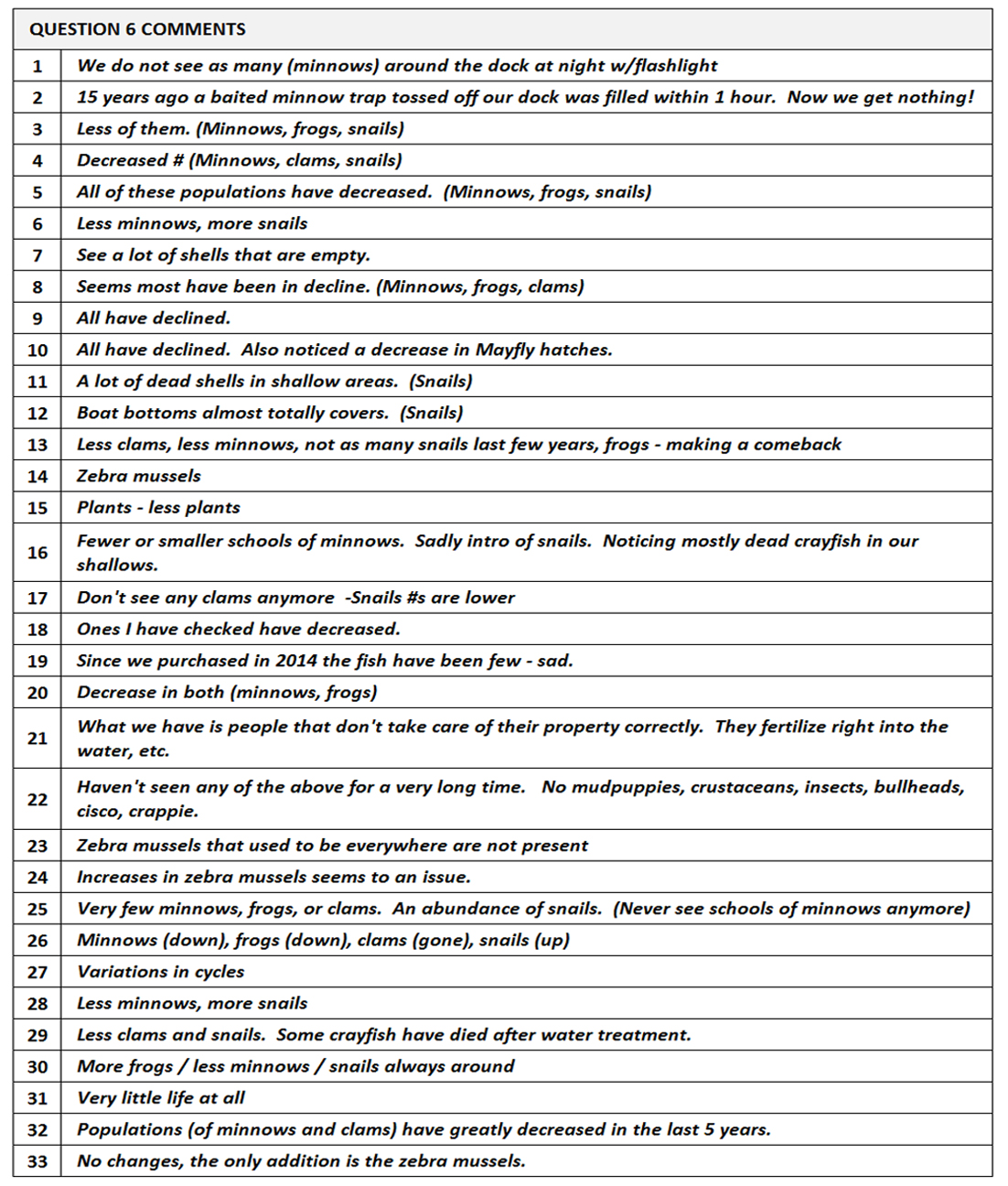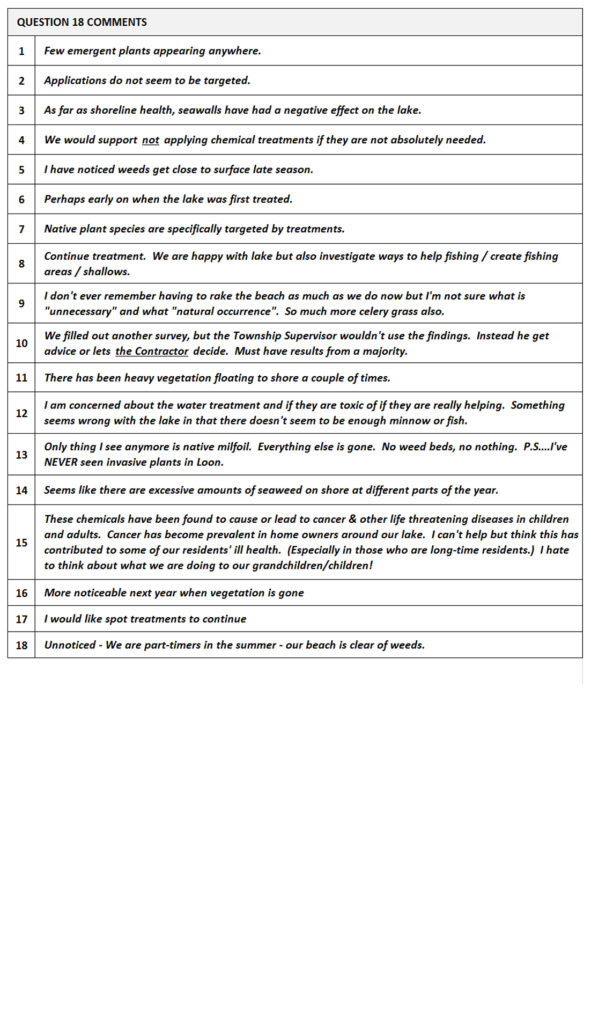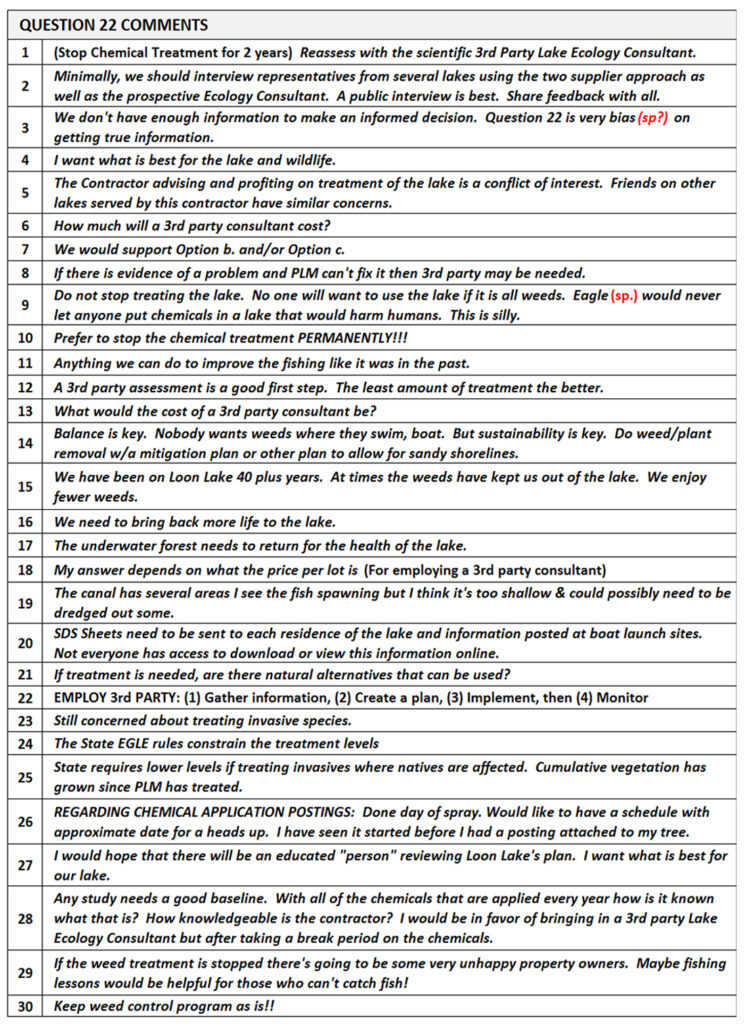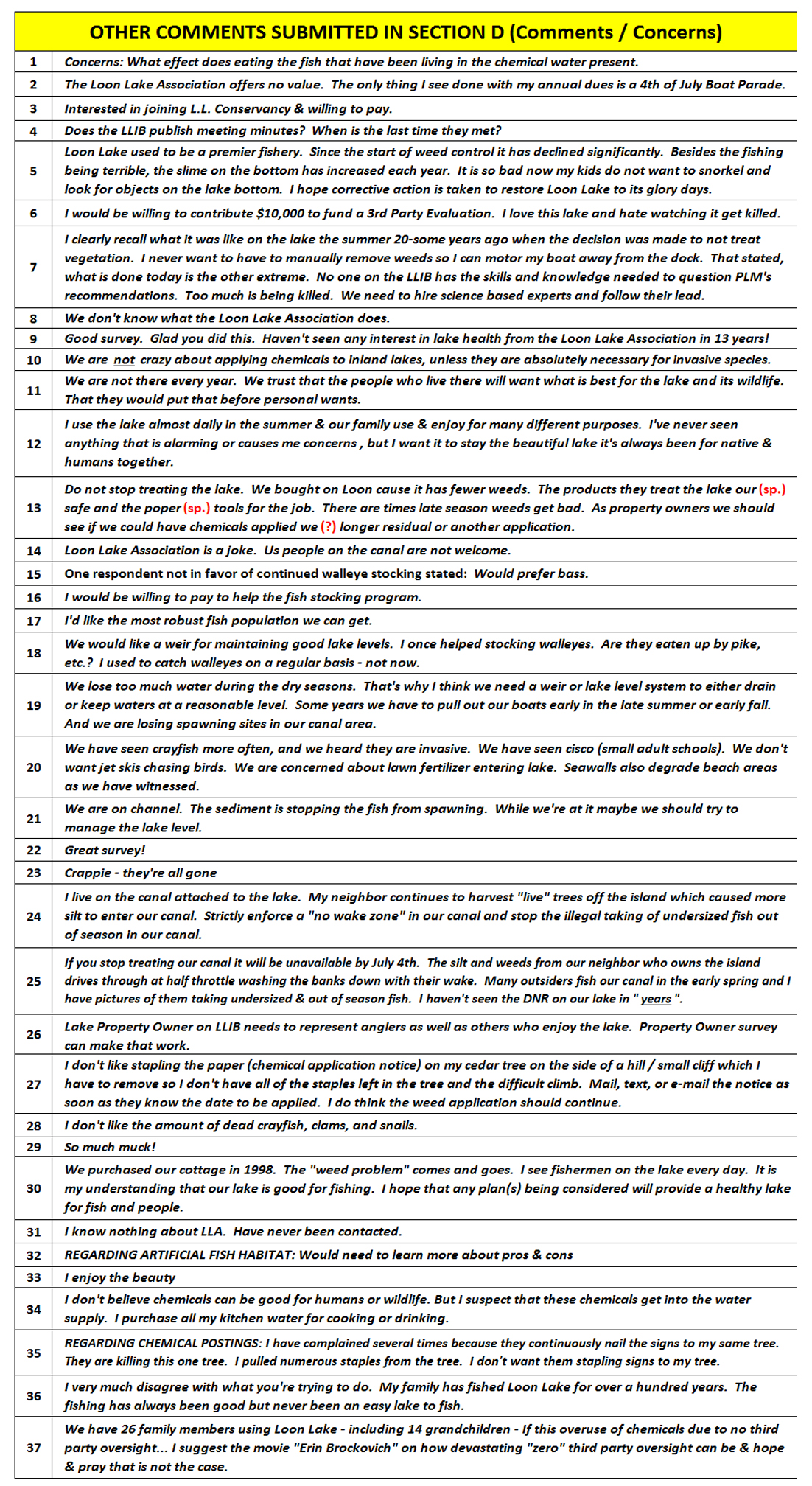Long Lake Property Owners
Based on a discussion with Mike Lesich, President of Long Lake Association:
Long Lake Property Owners and the group as a whole have been extremely pleased with the results of hiring RLS as an independent lake consultant, compared to previously only funding a chemical applicator. RLS conducts surveys of the water body for nuisance invasive plant species, and creates a management plan for the lake that strictly adheres to chemical application only in areas that are necessary for control. An RLS employee is in the boat while the application is made, to ensure the plan is adhered to. They have been adamant about keeping Copper algaecides out of Long Lake completely. Mike’s assessment is that the lake spends approximately the same dollar amount total (RLS + APPLICATOR) than they were previously spending just on chemicals. Last year, he stated approximately $50,000 total expenditure.
Loon Lake Conservancy
DNR Fisheries Biologist
After a review of a recent weed treatment plan submitted by the Loon Lake Chemical Applicator:
“It is not a surprise that they recommend more treatment……… I disagree with this and their interpretation that the native species are at ‘nuisance’ levels especially since they don’t indicate what cumulative cover level or percentage they consider the threshold for being a ‘nuisance’. They noted that the plant community has ‘slightly more density’ in 2015 than 2014, but they failed to mention that this is a common result of weed treatment. This happens because of the excess nutrients that is now ‘free’ in the system since there isn’t enough vegetation remaining to absorb all of it. The ones that remain will soak it up and experience rapid growth recolonizing the newly exposed sediment/’space’ – typically invasives will do this before the native species can. Excess ‘free’ nutrients is also why you see more algae growth on treated lakes, like Loon Lake.”
April Simmons
Fisheries Management Biologist, MDNR-Fisheries Division
Long-Time Loon Lake Angler and Lakefront Property Owner
Regarding my time on the lake I have put together some of my fondest memories and thoughts. My family built the cabins on the west side of the lake in the mid-1950s. They were attracted to the lake for its outstanding fishing. The shorelines used to see Bluegills bedding around the entire lake. Palm size gills which were a prize. The pike in the lake grew to Master Angler size, and there is a mounted 20lb fish still on the lake at formerly Paul Maddox place 4 places south of me. It’s not like pike of that size were caught every day, but to get pike in the 10lb+ range was not uncommon. The family winter fished for Cisco (Lake Herring) through the ice and I have home movies of them being iced. That was an annual winter event. There used to be schools of perch in the lake that would go as deep and far as you could see. In the summer we always Bullhead fished. It was a blast and good for the kids because we couldn’t keep them off the line. Good-sized fish in large quantities. I started specifically targeting bass in the lake in the late 80’s. To boat dozens of bass in any given day was normal. I registered a Master Angler smallmouth in 1990’s. One of my fondest memories as a youngster was boating into what is now the boat launch and the entire bay being full of bass. It was incredible. Like a pod of salmon building up outside of a river. This phenomenon also occurred with multiple species along the shore in the spring. One of my favorite things in the spring was to glass the shore with my polarized glasses and watch the fish mill around. It was a joy. My brother and his friends from Chicago have been annual visitors to the cabin for the Bass opener for 27 years this May. The decline in fishing has turned the trip into a “memory” lane-type vacation. Where we would boat over 100 bass in a week in 97-98-99, we now may boat 6, if we’re lucky. It’s disappointing, to say the least. This started with the weed treatments. As fishermen, we saw the decline, and it started with the treatments. Our shallow water weed beds which used to provide critical habitat for bass, pike, walleye, and panfish, have been killed off season after season, and little beneficial cover remains. The beds are ghosts and most go unused. I’m concerned about the hazards to human health these chemicals pose, in addition to what I believe they’ve done to our fishery.
Aaron M.
Long-Time Loon Lake Angler from Illinois
Good to see somebody trying to fix this. I’ve been fishing Loon Lake since 1997. Quite frankly, leading up to my first trip on Memorial day of 97′ I heard from Aaron and his brother, Alex, how great the fishing was and I was pretty skeptical. From the first day, it was pretty clear they weren’t overstating it. On the first three casts between Aaron and I, we had three bass all over 3 pounds. It took off from there and I’ve been up fishing Loon Lake for every Memorial Day since, though I can’t say I go up for the fishing anymore.
After that first trip in 1997, the next 3-4 years it was not unusual for the three of us to be able to catch and release 100 fish in a combination of bass, walleye and pike every day. We’d fish from early in the morning 6-7:00 am till 10:00 am and then go in until 5-6:00 pm and fish till dark. The 100 estimate wasn’t a hard number to do and Aaron had done that for over a decade prior. Considering how far north it is the size of the largemouth bass being anywhere from a pound to six pounds is pretty incredible……and there were a lot of those bigger three-pound plus fish. It’s important to note, we’d keep maybe 4-5 walleye each year for a fish fry but everything else went back.
Then they started weed killing which we found out about from a flyer posted to a tree by the dock and a rather big water boat dumping bags of chemicals overboard. After that, the change in the quality of fishing was immediate. The amount we caught dropped steadily every single year from 2001 on with only a couple of exceptional years sprinkled in with none of those exceptional years coming in the last 10 or 12. Quite honesty, it gets worse every year. Today, if the three of us can go out and each come back with 4-6 bass, walleye or pike in total between the three of us………that’s about the most you can expect. It’s pretty sad, really. What was as good of a fishing lake as one could find almost anywhere has been reduced to something quite poor.
Best of luck getting this changed. If it can be restored to even a third of former glory that would be amazing! If I can help in any way let me know.
Jim C.




